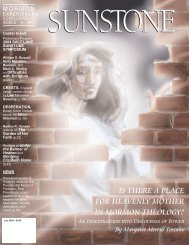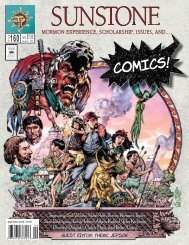00a_cover cmyk dark blue.qxp - Sunstone Magazine
00a_cover cmyk dark blue.qxp - Sunstone Magazine
00a_cover cmyk dark blue.qxp - Sunstone Magazine
You also want an ePaper? Increase the reach of your titles
YUMPU automatically turns print PDFs into web optimized ePapers that Google loves.
S U N S T O N E<br />
clients’ trials. It’s rare that I represent someone who owns a<br />
suit or even a dress shirt. Most can’t even tell me their<br />
clothing sizes. The great majority are in their late teens or<br />
twenties.<br />
One thing I notice among a good many of my clients is<br />
their very limited verbal skills. Very often, they have such<br />
limited means of expression that they have a difficult time relating<br />
information to me about their crime and their lives.<br />
They cannot explain themselves to judges. They often get<br />
very frustrated by their inability to be understood. I believe<br />
that this limited power of self-expression is directly related to<br />
the violent interpersonal conflicts for which so many of them<br />
find themselves in trouble.<br />
We have both a culture of the poor and a culture of the<br />
comfortable in our society. Much of what I have observed as a<br />
public defender is the result of the friction created as these<br />
cultures collide.<br />
No matter how long I do this work, I am still regularly<br />
stunned by the ignorance of some of my clients, manifested<br />
by their foolish, often self-destructive, decisions in their<br />
cases. As often as not, I am appointed to represent someone<br />
who has a lifetime of bad decision-making, and my job becomes<br />
an effort to try to get them to make rational decisions<br />
about how to handle their criminal case. It’s a tough sell. On<br />
a purely intellectual level, I feel I have insight into the forces<br />
which brought them to this point in their lives, but the reality<br />
of dealing with this client base can be frustrating and, at<br />
times, infuriating. At least once a week, I have to suppress the<br />
urge to strangle someone.<br />
My public defender clients fall roughly into the following<br />
groupings (though there is considerable overlap, with many<br />
falling into several of these descriptions).<br />
The Real Anti-Socials. These are the truly mean, those whom<br />
mental health professionals would likely classify as having an<br />
Anti-Social Personality Disorder. Fortunately, they are a very<br />
small slice of my client base. Generally, they do not or cannot<br />
feel empathy for other people. They do not concern themselves<br />
with the physical fear or pain, or the psychological<br />
terror, economic hardship, inconvenience, or just plain<br />
damage that they do to others. A few twisted individuals<br />
seem to take pleasure in inflicting pain and fear. It gives them<br />
a sense of power or control they don’t otherwise feel in life. 4<br />
This delight in hurting others does not make them especially<br />
accomplished criminals because they get caught often<br />
with minimal effort by law enforcement. Much of their conduct<br />
is self-defeating. Usually the gain they realize, or hope to<br />
realize, for their criminal behavior is minimal: fifty-dollar<br />
armed robberies, five-hundred-dollar forged check scams,<br />
sexual assault in a world where consensual sex is easy to find.<br />
Included in this group are those filled with rage. I see a lot<br />
of anger targeted at almost anyone they see as an authority<br />
figure or who just seems to be in their path. The more angry<br />
and defiant they are, the more likely they are to be self-destructive<br />
in their behavior. I suspect there is often a lot of selfloathing<br />
behind their anger.<br />
Not surprisingly, this group includes some of the murderers<br />
I have defended in capital cases, but it’s a minority of<br />
them. If I had to make a mental note of the meanest people I<br />
have represented through the years, very few of them would<br />
be murderers, and in those cases, they would be the chronic,<br />
violent young men whose lives are filled with conflict and almost<br />
no meaningful relationships.<br />
Substance Abusers. A substantial portion of those charged with<br />
drug crimes are either addicts, who are often small-time<br />
dealers simply trying to support their own habits, or the<br />
mentally ill and the damaged who are self-medicating. Many<br />
people in this category live lives of complete disaster. They<br />
are poor, have no job skills, few interpersonal skills; they<br />
have terrible diseases such as AIDS or schizophrenia with<br />
little or no treatment; they are not part of intact families,<br />
sometimes for reasons completely beyond their control; they<br />
have been raped or abused as children; they are simply overwhelmed<br />
by the challenges of life. They drown in hopelessness<br />
and see nothing but more despair in their future. Drugs<br />
and alcohol serve as an opiate to make the hours tolerable.<br />
Another part of this subset is the mentally ill who for reasons<br />
we are still trying to understand are disabled by hallucinations,<br />
extreme anxiety, deep pits of depression, or manic<br />
episodes. The beer and the crack dampen the voices in their<br />
heads, quiet the jangled nerves, or bring sleep or stupor.<br />
There is a much smaller group who use various illegal<br />
drugs and alcohol primarily, they say, because they enjoy the<br />
sensation, but I am rarely called upon to represent one of<br />
them. Typically, I interact only with such a user when they<br />
run over someone while under the influence.<br />
Because of my Mormon upbringing, it has been hard for<br />
me to fully understand the pull of substance abuse. Other<br />
than minimal college experimentation in the 1960s—I did inhale—I<br />
simply have no personal experience to measure<br />
against what I learn about these clients’ lives. One addicted<br />
client described his relapse into cocaine use as his “being possessed<br />
by unclean spirits.” He had been in a faith-based treatment<br />
program and meant it literally, but it struck me as a very<br />
apt metaphor. He was one of the fortunate few with a supportive<br />
middle-class family who made sure he was admitted<br />
to a residential treatment facility.<br />
While handling a Florida death penalty case, I first encountered<br />
the devastating condition of Fetal Alcohol<br />
Syndrome and the less-often-diagnosed, and therefore more<br />
sinister, Fetal Alcohol Effects. These devastating disorders of<br />
the brain and neurological system that affect behavior result<br />
from their mother’s alcohol consumption during pregnancy.<br />
There is no cure. All of their lives, these children are disabled<br />
by conduct that occurred while they were in the womb. 5<br />
The Mentally Retarded and Mentally Ill. Only rarely are criminal<br />
defendants evaluated to determine the extent of mental<br />
retardation or mental illness. Defendants can be very disadvantaged<br />
in these ways yet still be competent to stand trial. 6<br />
An insanity defense requires that their mental illness com-<br />
SEPTEMBER 2006 PAGE 33

















